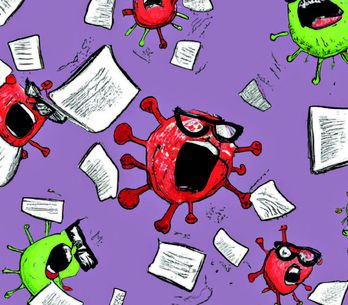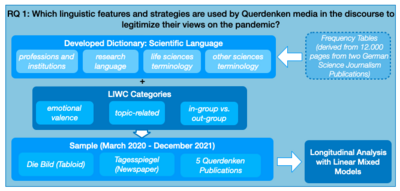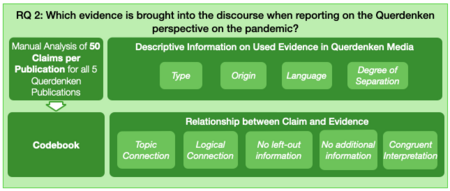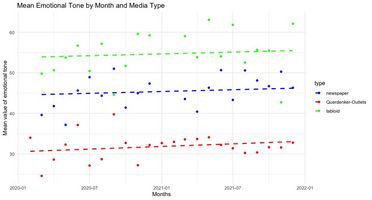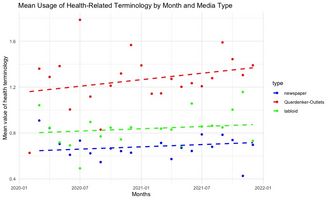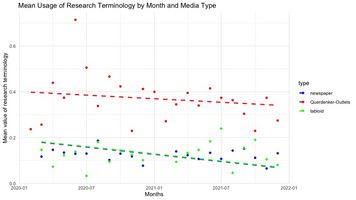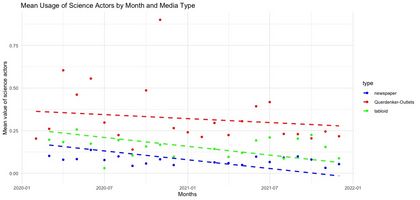VINFO - Virulent Information
Decoding the Discourse: Analyzing the Linguistic Features and Strategies behind the Querdenken Movement's COVID-19 Narrative
VINFO at IC2S2 '23 in Copenhagen
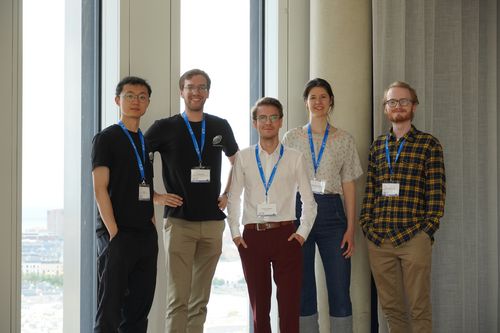
View the final Project Report of #class22 Team "VINFO"
Our team 'VINFO' (short for 'virulent information') focused on the structure, spread and substance of COVID-19-related content. Our point of interest was the German-speaking 'Querdenken' movement, especially its online journalism. We analyzed Querdenken online articles empirically, quantitatively and qualitatively. Doing so, we utilized different approaches, notably quantitative as well as qualitative content analysis.
Background
Since about mid-2020, the main organizer of the protests against protective measures for COVID-19 pandemic in Germany has been a semi-organized group called Querdenken (lit. 'lateral thinking'), which was initially based in Stuttgart but soon started to organize rallies and demonstrations also in other cities.
The group is a non-centralized movement consisting of individuals from varied backgrounds, including anti-government protesters, supporters of various conspiracy theories, anti-vaxxers and members of the far-right. Previous research has shown that different actors of the ‘Querdenken’ movement have different motivations in their political support and they are often united by anti-scientific content, published and distributed online. These Querdenken online articles were the subject of our research.
Research Objectives
COVID-19-related misinformation can be created or adapted from the truth to attract the attention of target groups. In our project we analyzed the usage of scientific information which leads to (mis)information in the Querdenken community. We were interested to understand this COVID-19-related (mis)information in more detail in terms of its structure and spread, and to do so we closely looked at Querdenken online articles.
Our research questions were:
- Which linguistic features and strategies are used by Querdenken media in the discourse to legitimize their views on the pandemic?
-
Which evidence is brought into the discourse when reporting on their perspective on the pandemic?
Methodology
First, we examined the Querdenken online articles in terms of their emotional tone and in terms of their scientific terminology. To do this, we used language analysis tools such as LIWC (Linguistic Inquiry and Word Count) and a self-created dictionary about scientific terminology based on various science journals.
We completed our scientific language dictionary in September 2022. Here, we used a sample of around 3,000 articles from ZEIT Wissen, and 7,000 pages from Spektrum der Wissenschaft to obtain frequency tables for words which where then filtered by human raters in four different subcategories:
- Professions and institutions associated with sciences
- Research-related terms
- Life sciences terminology
- Terminology from other sciences
In a second step, we qualitatively examined a certain number of Querdenken online articles as a sample. We traced back the sources of the articles, investigating if they could be linked to specific scientific publications. Later on we focused on similarities and differences between the Querdenken online articles and the original scientific publication, or in other words, investigated how they align with each other.
Main Findings
Please see our project report for more information.
Querdenken media COVID-19 coverage is more negative, more health focused and uses more scientific terminology (research related terms) as compared to newspaper and tabloid articles.
COVID-19 coverage for all media types used more research terminology and terms associated with scientific professions and institutions at the beginning of the pandemic.
Querdenken media predominantly uses and cites sources as evidence but fails to deliver the same interpretation as them:
- 45% of claims lacked congruence interpretation
- 31% of claims used additional non-cited information
- 23% of claims had no logical connection to the cited source
- 3% of claims had no topical connection to the cited source
There is considerable variation in the number of articles of Querdenken media that are not original content. For example, of the analyzed Transition News and Uncut News claims 78% and 18% were translations of other articles, respectively.
Conclusions and Outlook
Our findings show that Querdenken media outlets appear to place an emphasis on seemingly scientific contents in their coverage of the pandemic, potentially as a means of generating legitimacy. On the other hand, tabloids and newspapers reflected on the pandemic as a 'polycrisis' situation which affected many aspects of life instead of a purely 'scientific crisis'. Results from our qualitative content analysis further showed a poor congruence between the claims put forward and the sources used, even though a considerable fraction of their claims were sourcing governmental or scientific institutions.
To combat the spread of disinformation, we recommend policymakers to direct international attention to movements which legitimize and promote misleading information. Furthermore, science communicators should tie in scientists more frequently and deliver clear and non-ambiguous interpretations to leverage higher trust in science; on the flipside, scientists should be aware of and utilize their own value in public discourse.
TEAM
- Pia Gutsmiedl
- Max Hampel
- Seong-Min Jun
- Cheng Pan
- Valentin Pauli
- Alexander Sobieska
- Rosa Weidenspointner
TUTORS
- Junianna Zatsarnaja
- Paul Sieber
SUPERVISORS

